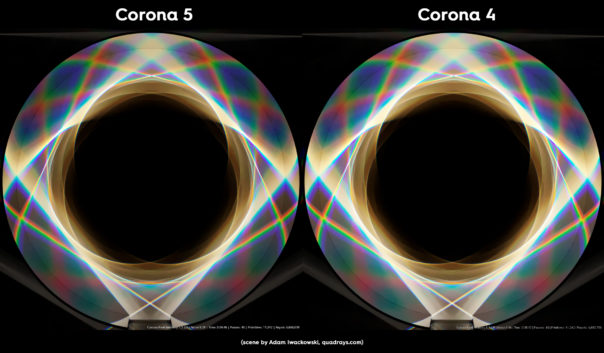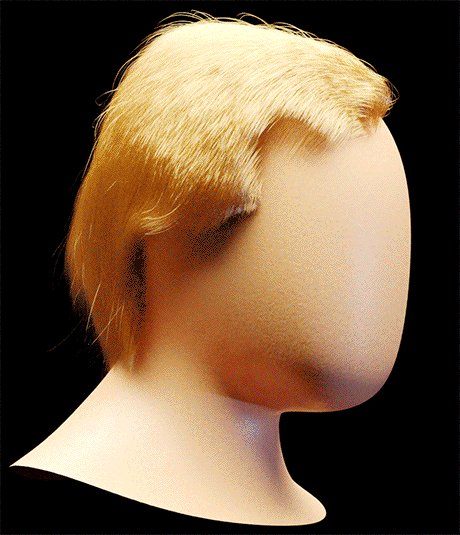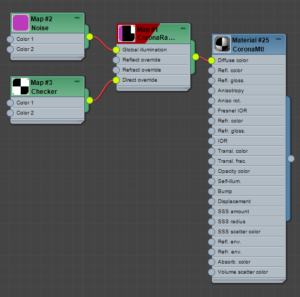
We’re pleased to announce the release of Corona Renderer 5 for 3ds Max! This release focuses mostly on optimizations, saving both memory and render times for general rendering, and more specifically for displacement and caustics.
NEW FEATURES VIDEO
For those who prefer to watch than read, here’s the New Features video:
DOWNLOAD
Grab the latest version while you read! It’s available at:
https://corona-renderer.com/download/
Demo Refresh: If you have tried a previous version of Corona Renderer and your 45-day trial has expired, then you’ll be pleased to hear that we have automatically refreshed the demo period to give everyone an extra 14 days! Simply download and install Corona Renderer 5 from the link above, and activate the demo license right within 3ds Max. Enjoy!
QUICK FACTS
- Memory and render time savings right out of the box, without the need to change anything in the scene.
- 2.5D Displacement – New default displacement calculation method, which gives you much faster scene parsing and even more memory savings.
- Caustics Optimizations – Caustics render faster and use less memory, no changes needed to the scene.
- General Optimizations – There are overall memory and render time savings, including for geometry processing and more.
- ColorCorrect Optimizations – The performance of the Corona Color Correct map has been improved.
- Hair – Corona now uses half the memory, and some artifacts have been removed.
- Corona Material Library updated (17 new basic Hair materials, 10 new Skin materials, and some smaller fixes).
COMPANY NEWS
WELCOME NEW TEAM MEMBERS!
We’ve had great responses to our previous job openings, and the team is now at 42 people, and growing regularly! Please welcome these new members to the Corona team!
- Vojtěch Tázlar: Research intern
- Ondrej Poláček: Intern, 3ds Max team
- Matúš Goliáš: Intern, development
- Branko Novakovic: Support Specialist for Cinema 4D
- Jakub Šťasta: Developer, 3ds Max team
- Matěj Hoffmann: Intern, QA Automation
- Baudouin Feildel: Developer
- George Karampelas: 3ds Max support specialist
WE ARE STILL EXPANDING!

We’re not done yet though, we’re still looking for candidates to fill a few other roles here, such as a Product Marketing Specialist, QA Specialist, and C++ Developers. If you would like to be part of the team, be sure to check out the job openings and send in your application. We look forward to hearing from you!
CORONA RENDERER FOR CINEMA 4D

Just over a month ago, we added Cinema 4D R21 compatibility with the release of Corona Renderer 4 for Cinema 4D (Hotfix 3). We’re working hard on Corona Renderer 5 for Cinema 4D – naturally it will have R21 compatibility right out of the gate, and the optimizations listed here for the Corona core, but it will also bring greater parity with Corona Renderer for 3ds Max by adding some more features from the core into Cinema 4D, plus its own optimizations and bug fixes.
MAJOR FEATURES
2.5D Displacement
“I AM IMPRESSED! I did a 5k render with the old displacement vs the 2.5D – memory usage went from 130gb to 60gb. For us at The Boundary, it already looks like it is going to be a game changer.”
Peter Guthrie of The Boundary, on testing the Corona Renderer 5 daily builds
The new 2.5D Displacement will help you make the most of your RAM, offering substantial savings on memory usage. 2.5D Displacement is the default in all new scenes, and if you open an existing scene you can choose to instantly and automatically swap over and take advantage of those memory savings!
In the full size comparison, you can see the render stamp for each render. Here, Corona Renderer 5 used around 24% less RAM, took 12.6% less render time, and all this with more detail in the displacement geometry.
2.5D Displacement allows the use of a smaller Screen or World Size value, which means more detail in the geometry created by displacement while still needing less memory.
Loading an existing scene will ask if you want to swap to this new displacement. If you choose yes, then the Screen Size value for the scene will be adjusted automatically – for example, if your existing scene had a Screen Size of 3, it will automatically be adjusted to a value of 2 (you can of course make further adjustments to it yourself if needed). If you manually set up the new 2.5D displacement, setting Screen Size to two thirds of its previous value is a good guide, the same as the automatic set up would do.
2.5D Displacement also offers significant savings on Parsing Time, as seen below:
From our tests, we have found:
- Geometry processing can be up to 3 to 4 times faster on average, but up to 20 times faster in some extreme cases
- Rendering speed gets a few percent of an increase on average, but up to 3 times faster in scenes with heavy displacement
- Uses only half the memory on average, but up to 10 times less memory in some extreme cases
Please note – all our tests and all feedback from users so far has shown that 2.5D displacement is far better than the old displacement. Unless we hear of any experiences that contradict this, we plan at some point in the future to remove the old displacement from Corona Renderer and leave only the 2.5D displacement.
Known Current Limitations:
– Using a CoronaLightMtl on an object which has 2.5D displacement may give undesired results – you can read this article for more information
– 2.5D displacement does not work with the Fast mode of the Rounded Corners map (only where displacement is applied to the same object as a Rounded Corners map; Fast mode will still work for all objects without displacement applied, even if 2.5D displacement is enabled)
Caustics Optimizations
Caustics have been optimized, and you can simply load any existing scene and you will find it renders faster and requires less memory (or of course get those benefits in any new scene you create)
In the example above, by simply opening the scene and rendering with no changes, Corona Renderer 5 saved 48% memory, and needed around 8% less render time.
(One thing you will note in all these comparisons is that the caustics intensity has changed slightly with Corona Renderer 5, due to more accurate calculations).

The above prism scene (Adam Iwackowski, quadrays.com) is almost nothing but caustics, so we can narrow down the performance gains from the caustics improvements alone (rather than gains from geometry parsing, instancing, etc.). Here we see that Corona Renderer 5 saves 16% memory, and needs 31% less render time.
Caustics have also been improved with multiple lights:
In this example – also almost pure caustics – we see a 25% less RAM and 23% less render time required.
Caustics now also respect the Include/Exclude list of lights, so in addition to the usual effects of excluding an object from a light, that object will also no longer create reflective or refractive caustics from that light.

Conversely, if you create an Include list, then only objects in that list will generate reflective and refractive caustics from that light (in addition to the usual effects of adding objects to the Include list for the light).
This can be used for:
- Artistic purposes, to get a desired result
- Control over multiple objects that use the same material (rather than create separate materials with refractive caustics on and off)
- Optimizations to render times by removing objects that generate some caustics which do not contribute significantly to the result
(do keep in mind that you are excluding the object from ALL interactions with that light, not just the caustics aspects of that light – you could of course duplicate the light source, to have one “caustics only” light that only generates caustics for particular objects)
Corona Material Library Updates
17 new basic Hair materials and 10 new Skin materials were added to the material library:

Also, the tiling size of normal maps in the Oak Honey Floor and Oak Northland Floor materials was fixed, as was an inconsistent tiling size in the Stone -> Cobblestone Herringbone material.
Hair Optimizations
Corona now only needs half as much memory when rendering hair (Max native, Ornatrix, or Hair Farm). This translates into an overall 20% memory saving for the scene, once you add in the memory used by Max and the hair software. These updates also remove some artifacts.
Other Specific Optimizations
The performance of the CoronaColorCorrect has been optimized, and Bloom & Glare is now 10% faster and uses 20% less memory.
Overall Optimizations
We’ve done a lot of work on generally optimizing Corona Renderer. This includes things like a rewrite of the geometry processing, a switch to the latest Embree library, optimizing the calculation of mesh normals, optimizing geometry processing time and IR restarts in scenes with larger number of instances, and more.
These mean that all Corona Renderer scenes will be faster/need less memory (not just those using displacement or caustics).
This means you will see benefits without making any changes to your scene settings at all:
In the example above, Corona Renderer 5 uses around 9.6% less memory, and takes 36% less render time, all without making any changes (the scene wasn’t even converted to 2.5D Displacement).
Updated the NVIDIA GPU AI denoiser to the latest version
- Better compatibility with other plugins which also use NVIDIA CUDA and OptiX frameworks
- Improved performance with Turing GPUs
- Better error reporting
- Requires NVIDIA GPU driver version 418.81 or newer
- Please note – NVIDIA has also removed support for Kepler-based GPUs, and their AI denoiser now needs Maxwell-based cards or newer. This is not something we can control of course, but we want all our users to be aware before installing. Conversely, in our tests some Maxwell-based mobile GPUs can now run the NVIDIA AI denoiser, where they couldn’t previously.
SMALLER IMPROVEMENTS
- When a material with a RaySwitch map in the Diffuse slot is shown the viewport, the map from the Direct Visibility override is now displayed instead of the map from the GI override:

- Improved text rendering in the Render Stamp
We’ve used an improved font for the Render Stamp, which will make it easier to read in all images but especially on high resolution monitors. (If you want to change the size of the font, you can use the string options)

- “Setup LightMix” button added to the multiple environment maps dialog
- Optimized the Corona Distance Map when Corona Scatter is plugged into it as a distance-from object. Brings up to a 30% speed increase in extreme cases
- Optimized scene parsing time for scenes with a high number of instances, up to twice as fast in scenes with around 5 million instances
- High Quality Image Filtering – moved from being a separate checkbox into the dropdown list of filter types
- Changing render regions now resumes IR if it had previously stopped by hitting the IR pass limit
- “[IR]” tag added to the VFB title bar, to show that the image was rendered with IR rather than a final render
- Faster IR restarts in scenes with a CoronaSun (or more than one CoronaSun)
- The Corona Color Picker now displays the Corona icon in its title bar
- Added a help button to the Autosave path which explains the special tokens that can be used (similar to those used in the render stamp)
- Copy clipboard option added to the CIE
- Bloom & Glare progress bar now added to the CIE (just like the one already in the VFB)

- Updated the Intel CPU AI denoiser to version 1.0 – this fixes the appearance of “ghosts” in the denoising for objects that are not visible in the scene due to a lack of lighting, and lowers memory consumption for higher resolutions (2K or higher)
- Added a warning which is shown when there is a NaN (invalid pixel value) in the renderer image. This warning has a link to the helpdesk so that you can easily let us know about the problem by filing a bug report
- Added “Unpacking and installing” message to the installer, so that you will know that something is still happening after the NVIDIA AI denoiser or the Material Library are downloaded
- When doing an Unpack install, the Installer now detects when the selected directory contains any files, and asks if you would like to override them or cancel the unpacking
- Changed the directory structure for the installation of Corona Renderer – we no longer install DLLs into the 3ds Max root folder, but instead install those to the Program Files folder
- Added an option to disable the “Startup scripts enabled” warning in 3ds Max
- Added support for SiNi Scatter
BUG FIXES
General Fixes
- Fixed wrong color of toggleable buttons
- Fixed the Proxy “Hide out of range” animation option (it was hiding the proxy too early)
- CXRs now saves information about the camera used at render time (VR, type, etc.)
– This allows the CIE to computer Bloom&Glare correctly for different camera types (Note, this only applies to CXRs saved from Corona 5 and newer of course – existing CXRs will not have this information added to them retromagically!) - Fixed normals that were wrongly computed in some cases
- Fixed radio buttons disappearing from different sections in the Corona Camera
- Fixed .conf file parsing error on opening Render Settings or starting a render, which occurred after certain values were saved as defaults in the Render Settings (e.g. when Image Filter Type is set to Symmetric Tent by default)
- Fixed not being able to reload a .conf file saved from the CIE, which happened in some cases (e.g. when the NVIDIA or Intel AI denoisers are selected)
- Fixed Falloff map in camera space not reacting to camera movement
- Fixed Corona Camera Tilt and Shift not being updated on opening a scene
- Fixed the VFB stopping updating after drag and dropping LightMix colors
- Fixed caustics disappearing with more passes in some scenes
- Fixed the SSS material rendering wrong when inside glass with Refraction Glossiness of <1 when caustics were enabled for the glass material
- Fixed the Corona Sky map not working correctly with multiple Suns in the scene
- Fixed LayeredMtl layers affecting displacement
- When LightMix is recreated using the LightMix setup dialog, the LightMix configuration (colors and enables) will be reset to defaults
- Fixed using saturation -1 not resulting in completely grayscale image
- Fixed autosave saving material editor renders
- Fixed appearance of unwanted hard edges when rendering overlapping scattering media
- Fixed pan & zoom rendering wrong offset when zooming in
- Fixed .scn and .cxr file extension associations stopping working when the installation path to Corona Standalone or Corona Image Editor was changed from previous installation
- Fixed IR freezing when using ProBoolean
- Fixed artifacts when using a dark environment map
- Fixed result being automatically saved to render history when the render is cancelled
- Corona Color Picker now updates the color as soon as you start modifying the hexadecimal color representation
Crash Fixes
- Fixed crash when switching a CoronaLight on or off during IR
- Fixed 3ds Max sometimes crashing during parsing when the point cache modifier is used
- Fixed crashes when loading malformed proxy files
- Fixed crash when NVIDIA AI libraries cannot be loaded
- Fixed crash when rendering the 3ds Max volume light effect (in atmosphere effects)
- Fixed crash when opening some scenes using CoronaCamera auto tilt
- Fixed crash when old displacement with water level is applied on an object with unusual geometry
- Fixed rare crash when rendering an isolated object
- Fixed random crashes when (de)selecting Corona objects, maps, and materials
Installer Fixes
- Fixed installer reporting an incomplete size after successfully downloading the NVIDIA AI denoiser or the Material Library (e.g. “218.9 MB / 220 MB”)
Licensing Fixes
- Fixed Corona so that it looks for the Licensing Server on all network interfaces
- The “Activate License” button in the System tab of the Render Setup now does not need to be clicked multiple times to get it to activate
- The System tab in the Render Setup no longer claims there is no license when one has been acquired from the Licensing Server
- Fixed license activation not working in some cases when running Corona on the same machine as the Licensing Server
WHAT’S AHEAD
The Corona train never stops at any station for long! Now that Corona Renderer 5 is out, well be starting work on the next version – and of course, Cinema 4D users can look forward to the release of Corona Renderer 5 for Cinema 4D soon.
While Corona Renderer 5 was very much focused on optimizations, next time we’ll be turning our attention to pushing the feature set ahead once again. Things we are considering include a new grounds-up PBR material, a Slicer/Clipper material, reworking the tone mapping, and more.

As well as the Hair and Skin materials included with this release, we’ve also been creating more new materials for the Corona Material Library. Although we have many that are already complete, we are still putting the final touches to some. Once those additional updates to the library are complete, we’ll look at how best to release those (perhaps in the Corona Renderer 6 dailies, or perhaps as an update to previous Corona versions).
You can follow the timetable for our ongoing journey at the 3ds Max roadmap and at the Cinema 4D roadmap.
DOWNLOAD CORONA RENDERER 5
No need to scroll back up to the top of the post to download, here’s the link again for those of you dedicated enough to read everything first!
https://corona-renderer.com/download/
Thanks!
There’s more to every Corona Renderer release than just the hard work the developers put in, so as well as our thanks to them, we also want to extend that to our support, business partners, forum moderators, translators, testers, advisors, partners, resellers, all at Chaos Group, and of course to you, our users, for supporting us and for letting us know what you want to see added!
So to all of you, we’d like to say….
Thank you!
Adam, Ondra, and the Corona Crew

some novelty of Corona for archicad
Hi! Sorry, not sure if there is a question here or not 🙂 For the latest news and downloads of Corona Renderer for ARCHICAD, please visit the forums: https://corona-renderer.com/forum/index.php#c5
Thanks!
Tom
Hello, right after I used the installer for corona 5 i get two errors 1.coronamax2019.dlr cant run properly and the other one is about coronamaxutils2019.dlt so I had to go back to 4. Any idea whats causing it?
Hi! Sorry to hear you are having problems. For all crashes, bugs, installation problems etc, please follow the steps on https://coronarenderer.freshdesk.com/support/solutions/articles/5000524006-how-to-report-issues-3ds-max (developers and support are unable to monitor comments on the blog, so follow the steps on that page will ensure you get a timely reply). Thanks! Tom
Same to me . Any solution……? Thanks in advance BR marcel
Hi! I am not sure which part you are referring to with the “same” – if it was some bug or problem, please contact support. See https://coronarenderer.freshdesk.com/support/solutions/articles/5000524006-how-to-report-issues-3ds-max for info 🙂 Thanks! Tom
And I have the same problem 🙁 Max 2014
Hi! I am not sure which part you are referring to with the “same problem” – if it was some bug, problem with installation, etc., please contact support. See https://coronarenderer.freshdesk.com/support/solutions/articles/5000524006-how-to-report-issues-3ds-max for info 🙂 Thanks! Tom
I have got the same issure!
Hi! Sorry to hear you are having problems. For all crashes, bugs, installation problems etc, please follow the steps on https://coronarenderer.freshdesk.com/support/solutions/articles/5000524006-how-to-report-issues-3ds-max (developers and support are unable to monitor comments on the blog, so follow the steps on that page will ensure you get a timely reply). Thanks! Tom
Hello! Have you solved the problem?
If you are having problems and that is why you are asking, then for all crashes, bugs, installation problems etc, please follow the steps on https://coronarenderer.freshdesk.com/support/solutions/articles/5000524006-how-to-report-issues-3ds-max (developers and support are unable to monitor comments on the blog, so follow the steps on that page will ensure you get a timely reply). Thanks! Tom
You’re blazing fast, never ever compromising quality. Well done again.
Small spelling mistake on page I presume: “Silcer/Clipper material”
Yep, that’s a typo! Now fixed 🙂 Though it might have been interesting to find out just what a “Silcer” might have been 🙂 Thanks (for the kind words, and the typo info!), Tom
When I use setup Interactive lightmix .The lighting will reset
Hi! Yes, a known issue – we are looking at ways to make the reset optional. Meantime, you can either a) manually add any small number of extra lights to LightSelect rather than use the Automated set up, or b) you should be able to save and load the LightMix as .conf file (save before redoing the set up, and load afterward). Thanks!
I confirm the problem. This is a major inconvenience which can be remedied temporarily by saving the settings each time. I hope it gets resolved as soon as possible.
I’m a sketchup user. I just came across Coroner Renderer. Is it compatible with the sketchup platform?
There are no plans to create Corona Renderer for SketchUp at the moment (see https://corona-renderer.com/forum/index.php?topic=19185.0). However, many studios are starting in SketchUp, then exporting to 3ds Max (or Cinema 4D) for rendering. Hope this helps!
COME ON ! GO SKETCHUP
Hi! Unfortunately, there are no plans to work on a SketchUp version (see https://corona-renderer.com/forum/index.php?topic=19185.0).
Amazing progress, you guys are unbelievable! Really enjoy your product, thanks for the hard work.
Hi Tom. Please is there a separate LINK to download the material library for 3ds max. i find it a slow installation process when it has to download MTL online, especially over an ISP that isn’t fast and stable.
I want to be able to keep the MTL saved offline and then tell corona to install it offline whenever a new version of corona is released like in the previous versions.
Weldone corona team. hope to hear a quick response.
Thanks
There sure is – see https://coronarenderer.freshdesk.com/support/solutions/articles/12000036778-how-to-install-the-material-library-in-offline-mode-
Hope this helps!
(BTW, this is just what I do, keep the material library stored locally – so long as that file is in the same folder as the installer, the installer will use that rather than try to download it. Just be sure to check the news to know when a new one is out so that you don’t miss out 🙂 )
Corona is a great invention. Thanks to the technical developers, I would like to make a suggestion, is it possible to send out a Vray aerial personal in corona, which is very real when doing aerial view of the distant atmospheric environment
Hi! So that developers can track what features people would like (and how many are interested in it), we have a dedicated board over on our forum – please head to https://corona-renderer.com/forum/index.php?board=5.0 and post the request there 🙂 Thanks! Tom
Hello,
Does new Corona render utilize AVX2 ? And if it does: how much?
Peter
That would be one for the developers – please post over on the forums, as they don’t monitor blog comments (too busy developing!). https://corona-renderer.com/forum/ – thanks!
When can I make CPU noise reduction support AMD?
As noted in the article, the Intel CPU denoiser works on all CPUs, whether those are Intel, AMD or others 🙂 (It’s called Intel denoising as they are the company that developed it, not because of what it runs on)
Where do i can download corona render 5 without hotfix 1?
Not available at the moment – if you have a need for it, contact support (see https://coronarenderer.freshdesk.com/support/solutions/articles/5000524006-how-to-report-issues-3ds-max ) and let them know what the problem is with the hotfix. Thanks!